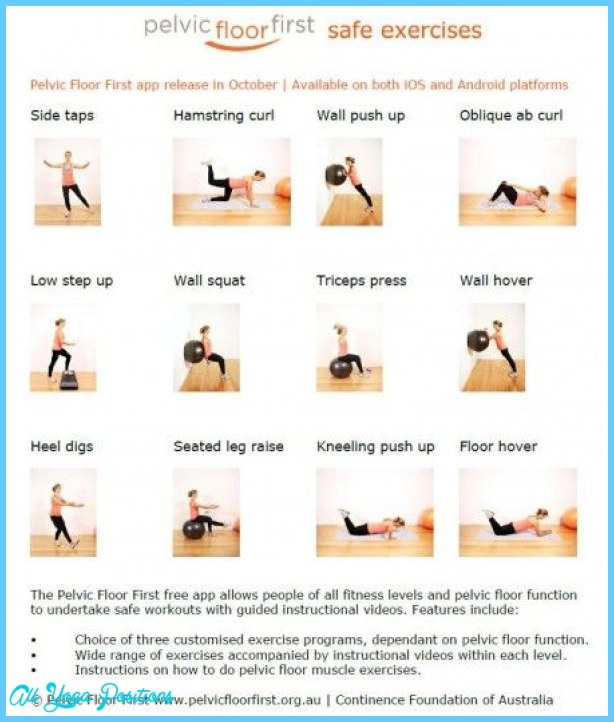Imagine this: you’re halfway through your pregnancy, feeling the familiar weight of your growing baby bump, and suddenly you experience an unexpected leak. It’s not just a little dribble – it’s a full-blown accident. This, unfortunately, is a common experience for pregnant women, and it’s often related to a weakened pelvic floor, the group of muscles that supports your bladder, uterus, and rectum. So, the question arises: can pelvic floor exercises help, and are they safe during pregnancy?

Image: www.reviewhome.co
Pelvic floor exercises, also known as Kegel exercises, are a powerful tool for strengthening these crucial muscles. These exercises are not just for preventing embarrassing leaks, they play a vital role in maintaining a healthy pregnancy and postpartum recovery. In this guide, we’ll explore the benefits of pelvic floor exercises during pregnancy, how to do them safely, and answer any lingering questions you might have about this essential aspect of prenatal health.
The Importance of a Strong Pelvic Floor
The pelvic floor is a hammock of muscles that stretches across the base of your pelvis. It acts like a floor, supporting your organs and helping control bladder and bowel functions. During pregnancy, your body goes through significant hormonal changes that can relax these muscles, making them less effective. This relaxation, combined with the growing weight of your baby, can lead to a variety of issues, including:
- Urinary Incontinence: The inability to control your bladder, leading to leaks during coughing, sneezing, or laughing.
- Fecal Incontinence: Difficulty controlling your bowels.
- Prolapse: When a pelvic organ, like the uterus or bladder, drops down into the vagina.
- Back Pain: A weakened pelvic floor can contribute to back pain.
- Painful Intercourse: Weakness in the pelvic floor can sometimes lead to discomfort during intercourse.
Pelvic Floor Exercises During Pregnancy: A Safe and Effective Solution
The good news is that pelvic floor exercises can be a safe and effective way to strengthen these important muscles throughout your pregnancy. Not only can they help prevent or reduce the potential issues listed above, but they can also prepare your body for labor and delivery, as well as speed up postpartum recovery. Kegels are a simple and effective exercise that can be performed almost anywhere.
How to Perform Pelvic Floor Exercises
To understand how to do Kegels correctly, it’s helpful to visualize the muscles involved. Imagine you’re trying to stop yourself from peeing or pushing out gas. The muscles you contract in these situations are your pelvic floor muscles.
Here’s how to perform a Kegel:
- Find the Right Muscles: Lie down, sit, or stand in a comfortable position. Breathe normally. Now try to tighten and lift the muscles in your pelvic floor. You should feel a tightening sensation and a lifting movement upward, as if you are trying to hold back urination. Be sure to avoid squeezing your buttock muscles or tensing your stomach.
- Hold the Contraction: Hold the contraction for a count of 5-10 seconds.
- Relax: Slowly release the muscles.
- Repeat: Repeat this process 10-15 times, several times a day.

Image: allyogapositions.com
Tips for Success
Here are some helpful tips to make pelvic floor exercises more effective:
- Breathe: Remember to breathe normally while performing Kegels. Holding your breath can strain your abdominal muscles and make it difficult to isolate your pelvic floor muscles.
- Regularity: Consistency is key. Try to incorporate pelvic floor exercises into your daily routine, like while watching TV or showering. Even a few minutes several times a day can make a difference.
- Listen to Your Body: If you experience any pain or discomfort, stop the exercise and consult your doctor or midwife.
- Seek Professional Guidance: If you’re unsure about your technique or need extra help, talk to your doctor, midwife, or a pelvic floor physical therapist. They can provide personalized guidance and even recommend biofeedback devices to help you strengthen your pelvic floor muscles.
Beyond Kegels: Other Exercises for a Strong Pelvic Floor
Kegels are a great starting point, but there are other exercises that can further enhance the strength and stability of your pelvic floor. Here are some examples:
- Squats: Squats engage your pelvic floor muscles and strengthen your legs and lower body.
- Lunges: Lunges work similarly to squats, targeting your pelvic floor and lower body.
- Bridges: This exercise strengthens your glutes and hamstrings, indirectly supporting your pelvic floor.
- Yoga and Pilates: These practices often include exercises that focus on core strength and flexibility, which benefit the pelvic floor muscles.
When to Consult Your Doctor
While pelvic floor exercises are generally safe during pregnancy, it’s always important to discuss any proposed exercise program with your doctor or midwife. They can assess your individual needs and make sure you’re engaging in safe and effective exercises. You should also seek medical attention if you experience:
- Excessive Leaking: Experiencing frequent urinary leaks or difficulty controlling your bladder.
- Pain During Exercise: Any sharp or persistent pain while performing pelvic floor exercises.
- Vaginal Discharge: Unusual discharge that is thick, smelly, or accompanied by itching or irritation.
- Protruding Organs: If you feel a bulge or pressure in your vagina.
Should You Do Pelvic Floor Exercises While Pregnant
Conclusion: Invest in Your Pelvic Floor
A strong pelvic floor is an invaluable asset throughout your pregnancy and beyond. By embracing pelvic floor exercises, you are investing in your health, comfort, and overall well-being. Don’t underestimate the power of these simple exercises. Whether you are struggling with incontinence or simply aiming to prepare your body for the exciting journey of motherhood, regular Kegels can make a significant difference.
Remember, consult with your doctor or midwife for personalized recommendations. By taking this proactive step, you can empower yourself to experience a healthier, more comfortable, and ultimately, more fulfilling pregnancy journey.





